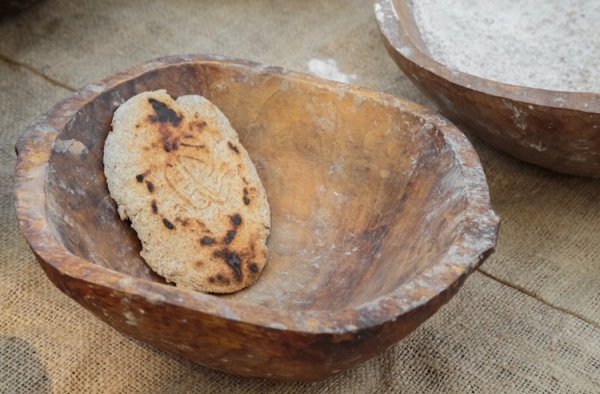The promising hacks to make ancient grains more formulation friendly in baked goods

Ardent Mills has released its inaugural Trend to Table report, which reveals 82% of consumers are seeking food options that cater to their health, wellness and greater wellbeing.
Which leans into the uptake of ancient grains among consumers.
Bread wheat dominates the bakery industry because of its versatility and functional properties, which helps doughs rise, form crumbs and brown crusts. However, while modern grains like wheats are bred for high yields, that’s left them vulnerable to pests and diseases and has also lowered their nutritional content.
Ancient grains, on the other hand, have recently been rediscovered as highly nutritious, healthy and resilient grains for solving the nutrition demand and food supply chain problems.
Listed by the Whole Grains Council as einkorn, emmer/farro, Kamut and spelt (all from the wheat family), along with sorghum, teff, millet, quinoa, amaranth, black barley and buckwheat, among others, ancient grains are more nutritious than their refined grain alternatives.
Many are gluten-free and higher in protein, omega 3 fatty acids, B vitamin and zinc – usually stored in the bran that gets eliminated during the refining process. They’re also a good source of fibre and absorbed into the body more slowly, which helps regulate spikes in blood sugar.
Because they’ve retained their genetic diversity, many are able to thrive in challenging growing conditions and are more pest- and disease-resistant than most mainstream grains. Obviously, this fact in coping well with lower levels of pesticides, fertilizers and irrigation also make them particularly appealing to the growing cohort of climate-conscious consumers.
And the figures speak for themselves. According to Absolute Research, the global ancient grain market size was valued at $8.6bn in 2022 and expected to sprout to $105.2bn by 2028.
In fact, another study looked into using ancient grains to help eradicate world hunger. Meeting the UN’s sustainable development goals (SDG) for zero hunger has become increasingly challenging in the face of increasing climate change and political and economic instability. An effective strategy to alleviate hunger and its severe implications is to produce affordable, nutrient-dense and sustainable food products.
The study provided a comparative analysis of different ancient grains with their modern varieties in terms of their physicochemical properties, nutritional profiles, health benefits and sustainability – aimed to guide policymakers in taking sustainable actions against malnutrition and hunger.
However, ancient grains have their drawbacks. Such as yield. Emmer, for example, produces about half the yield, while einkorn only 62% of their modern wheat counterpart.
Glutenin (a type of glutelin) makes up 47% of the total protein content of wheat flour, which is responsible for the strength and elasticity of dough.
Wheat gluten proteins consist of two major fractions: gliadins and glutenins. Gliadins are monomeric proteins, which can be separated into four groups: alpha-, beta-, gamma- and omega-gliadins.
Glutenins occur as multimeric aggregates of high-molecular-mass (HMW) and low-molecular-mass subunits held together by disulfide bonds. Breadmaking qualities are largely dependent on the number and composition of HMW glutenin subunits.
More importantly for the bakery sector, ancient grains have a different protein chemistry – in particular, lower levels of glutenin – which means the dough doesn’t form as well as its modern wheat counterpart.
Consequently, the end-product quality of baked products made from ancient wheat species is inferior to those that use common hexaploid bread wheat.
“There is very limited research on how to increase the functionality of these grains,” said Maneka Malalgoda, an assistant professor in the University of Manitoba’s Department of Food and Human Nutritional Sciences.
In partnership with graduate students Anashwar Valsalan, Filiz Koksel and Cristina Rosell, Prof Malalgoda set out to identify the processing approaches that make the use of ancient grains in bakery product formulations more feasible.
“We know that because of the chemistry of these ancient grains, they have limitations to their functionality. So, we wanted to explore how can we increase this.”
Value-add bakery products formulated with ancient grains are readily available today in mainstream retail – and the variety grows every year – however, it’s still a niche market, tagged with a premium price.
That’s likely to continue, at least in the short term, said Prof Malalgoda, simply because of grain availability. These grains are not grown as much as modern bread wheat, so food producers don’t have access to comparable economies of scale.
However, “given the recent interest in ancient grains, I thought it was a good avenue to explore,” said Prof Malalgoda.
“These grains have ecological and nutritional benefits as well.”
Bakery hacks
The study – recently published in Food Reviews International – focused on ingredients and processing technologies. An evaluation of current literature suggested a need to re-examine existing techniques, as well as their anticipated impacts on the functionalities of these underutilized wheat species for bakery.
The researchers identified some promising hacks to help ancient grains work better in baked goods.
- Hydrocolloids – already used widely by the bakery sector in formulating gluten-free options – facilitated with water retention.
- Pectin helped to increase volume, improve water retention and provide a springier and softer texture with a pleasing mouthfeel.
- Xanthan gum and guar gum assisted with dough stability, while improving volume.
- Enzymes like glucose oxidase were useful for strengthening gluten.
- Emulsifiers like lecithin improved loaf volume.
- The team also investigated processing techniques like tempering, flour blending, nonthermal plasma, heat treatments, extrusion, high pressure processing, ozone treatment and ultrasound.
- While all resulted in functional improvements, they found extrusion and nonthermal technologies worked better than others.
While each of the above holds particular promise, a lot more research is needed to really succeed in ancient grain formulation.
In fact, the study’s findings highlighted ‘that an indepth understanding of the physicochemical properties of ancient grains and the impact of the different functionality enhancement techniques on the chemistry of these grains is essential to successfully utilize different ingredient technologies and processing techniques/.
Which takes us back to the beginning to ask what the future holds for ancient grains in bakery.
According to Prof Malalgoda, the most feasible route forward is the use of blends. That is, mixes of modern and ancient grains at varying ratios that are sufficient to retain the desired functional and nutritional characteristics of both.
She and her colleagues are currently investigating this further, focusing on several approaches, including emulsifiers and extrusion and new processing techniques.
But before the movement can really take hold, she said, food companies need to show a growing demand in order to motivate farmers to grow more ancient grain crops.
“I think the key is to make sure there’s a market for these grains. And to get to that market, we need to make sure that they’re functional, or identify how to make them functional.”
From trend to table
Meanwhile, Ardent Mills’ Trend to Table report outlines the pivotal trends shaping the industry.
The analysis dissected over 10,000 survey results – one of the industry's largest efforts – to better understand what drives consumer decisions, while outlining opportunities to spark innovation in flour and grain-based foods across a wide range of industry sectors.
Notably, it highlights tension points within consumer preferences. For example, while 80% of respondents emphasize seeking healthier foods to meet their dietary goals, 68% also prioritize indulgent treats. This tension reflects the complex interplay between health-conscious choices and the desire for enjoyable, indulgent treats, presenting both challenges and opportunities for food manufacturers.
“We are committed to empowering our customers and serving as a steadfast partner to navigate the evolving food landscape,” said Angie Goldberg, chief growth officer for the North American flour miller.
“In addition to benefiting our customers, the insights from our Trend to Table report will play a role in driving purpose-powered innovation that guides us as we work to expand our product portfolio and our efforts to change the way the world is nourished,” said Angie Goldberg, chief growth officer for the North American flour miller.
Added Matt Schueller, director of Marketing Insights and Analytics, “The goal of this large survey and our Trend to Table report is to create a better understanding of these trends as well as an actionable roadmap for our customers. To move food forward, Ardent Mills will leverage this data with our customers to foster deeper, strategic partnerships to better meet consumer demand.”
Studies:
Majzoobi M, Jafarzadeh S, Teimouri S, et al. The Role of Ancient Grains in Alleviating Hunger and Malnutrition. Foods, 2023, 12, 2213. doi.org/10.3390/foods12112213
Valsalan A, Koksel F, Rosell CM & Malalgoda M. Ingredient Technologies and Process Modifications for Increasing the Use of Ancient Grains in Bakery Applications. Food Reviews International, 2023. doi: 10.1080/87559129.2023.2279613
Mini digest of ancient grains
Ancient grains are a group of grains and pseudocereals (seeds that are consumed like grains) that have remained mostly unchanged for thousands of years. They’re dietary staples in countries like China, India, Africa and the Middle East, and slowly building a popularity among Western consumers.
Amaranth: a gluten-free grain that has been cultivated for more than 8,000 years, linked to decreased heart disease risk and inflammation.
Millet is an ancient pseudocereal that’s gluten-free, noted to lower inflammation, reduced heart disease risk and improved blood sugar control.
Khorasan wheat, also known as kamut, is a high-fiber, nutrient-dense grain that is linked to reducing blood sugar levels and heart disease risk factors like LDL (bad) cholesterol.
Naturally gluten-free sorghum is the fifth most consumed grain worldwide and a great source of nutrients, including manganese, magnesium, copper and selenium, along with powerful polyphenol plant compounds, including anthocyanins and phenolic acids, which function as antioxidants.
Teff is the world’s smallest grain (approximately 0.7–1% the size of a wheat kernel) but packed with important nutrients, such as iron and magnesium. They are also one of the few grains that boast vitamin C, a nutrient vital for immune and bone health.
Freekeh is made from green durum wheat and packs a variety of nutrients and powerful carotenoid compounds, lutein and zeaxanthin, which is linked to a lower risk of degenerative eye disorders, such as cataracts and age-related macular degeneration (AMD).
Farro is an ancient wheat-based grain that’s high in vitamin B3, zinc, magnesium, fiber and antioxidants like polyphenols, carotenoids and phytosterols, which may lower the risk of heart disease and certain cancers.
Barley is among the most widely consumed ancient grains in the American diet, high in beta glucans (soluble fiber) that is linked to heart health.
Quinoa is a popular, gluten-free ancient grain that contains potent antioxidants, such as quercetin and kaempferol, which have been shown to have anti-inflammatory and anticancer properties. What’s more, it’s an excellent source of plant-based protein (8g/185g serving).
Bulgur, also called cracked wheat, is made from cracked durum wheat. It’s high fiber content may promote heart health, good digestion, blood sugar control and weight loss.
Rye is a popular ancient grain that is a member of the wheat family. However, compared to wheat, rye contains fewer carbs and more vitamins and minerals. Due to its high fiber content, rye and rye-based products may be more effective at alleviating constipation than wheat-based products and is linked to a reduced risk of certain cancers.
Fonio is a type of millet that’s widely consumed in West African countries. The two most common varieties are white fonio (Digitaria exilis) and black fonio (Digitaria iburu), which boast good amounts of magnesium, copper and zinc, along with resistant starch.



















